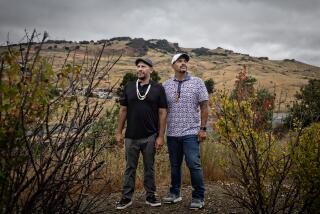Drive for Economic Independence : Choctaws Retain Culture as Their Business Thrives
- Share via
CHOCTAW INDIAN RESERVATION, Miss. — Like their parents and grandparents who thread beads and weave baskets out of swamp cane, many of the younger Indians on this wooded reservation work quickly and adeptly with their hands.
But it’s a variation of a theme: Today’s generation is weaving multicolored wires into intricate designs on an assembly line, producing complex electrical assemblies to go under the dashboards of trucks and sedans.
The Choctaw Indians are meeting production schedules for General Motors Corp., Ford Motor Co., Chrysler Corp., Westinghouse and American Greeting Cards. They’re punching time clocks, earning production bonuses, making decisions about which health plans to enroll in and playing on company softball teams. Their battle cries hang on banners inside their air-conditioned factories: “Quality, Our Most Important Product,” “Excellence Takes Desire” and “To Be Better Than the Rest.”
At the same time, workers converse in the Choctaw language. Preschoolers are taught the Choctaw culture by classroom aides. Some of the older Indians still gather for traditional dances and to chant their old songs. Stickball, the oldest organized ballgame in North America, is still played with a vengeance by teen-agers.
The Choctaws are perhaps the best example of the best form of life Indians can expect in modern America.
The system of reservations has stripped the Indian nations of vast lands and resources and has placed their communal traditions under great pressure to accommodate to an economic system based on individual achievement and exploitation of resources. The result in many instances has been tragic.
Seeking to sustain their way of life and yet unskilled in the ways of the white man’s economy, tribes have sold off land and mineral rights and other non-replaceable resources to raise cash. And yet, the cash too has often disappeared, siphoned into ill-conceived ventures or simply doled out to individual tribal members. With unemployment and alcoholism rife on the reservations, much of those payments find their way to liquor stores in nearby towns.
About a quarter of all urban Indians and a third of all rural Indians are living in poverty; Indian unemployment is about double the national average and approaches 80% on some reservations, according to government figures.
Bingo Parlors
An increasing number of tribal treasuries have sought refuge in bingo parlors, which attract non-Indian customers to the reservations by the thousands with huge jackpots in games that state authorities cannot regulate.
But bingo does not create many reservation jobs. And relatively few tribes--the Choctaws among them--have succeeded in developing steady employment bases for their members.
The Choctaws say they are driven by a desire to reduce their dependence on federal assistance--which is shrinking anyway--by developing their own tribal enterprises.
It is a philosophy of progress and accommodation championed among the tribes by a few aggressive leaders bent on achieving a long-term solution to Indian problems. They contend that the only way to preserve Indian culture is to make the reservations self-sufficient and economically secure, thus allowing Indians to continue to live by their traditional ways while earning money in ways their predecessors never could have imagined.
Fish Business
Today, the Metlakatla Indians in Alaska not only catch fish, but also process, package and distribute the product. The Seminoles in Florida operate a commercial fish farm to service restaurants and institutions. The Blackfeet in Montana, who for years filled government contracts for pencils and pens, are organizing their own bank. Cherokees in Oklahoma assemble computer components and operate a successful greenhouse.
In the long view of history, it is only half a loaf for many tribes who once roamed millions of acres in no need of time cards or production incentives. But for today’s tribes, there is little choice.
“I grew up with the liberal thinking that big business was bad, and we had been treated in such a way that kept us out of the enterprise arena. Now we’re beginning to realize that, if we want to be self-sufficient, we’re going to have to become entrepreneurs ourselves,” said Iola Hayden, a Comanche and executive director of Oklahomans for Indian Opportunity.
‘Dependency Syndrome’
“It’s a painfully slow process because we have lived in the dependency syndrome and because we don’t have a generation of entrepreneurs to look back on as an example. We are the generation to develop that,” she said.
Phillip Martin, the 60-year-old chief--and chief executive officer--of the 5,000-member Choctaw tribe, is one of the entrepreneurs. Before he began to drive the Choctaws toward self-sufficiency in 1979, the unemployment rate was 50%.
Today, the three businesses on the reservation owned in whole or in part by the tribe employ more than 1,000 people and generate $30 million in work annually, with enough profit to repay bank loans on schedule and some left over, earmarked for future expansion. The unemployment rate has been cut in half.
Earlier this year Martin was referred to in the Automotive News trade publication as “the Indians’ Lee Iacocca.” Herman Alford, a prominent attorney in nearby Philadelphia who has worked with Martin on business deals, calls him “the Moses of the Choctaws. He delivered them from the fields and into the factories.”
‘Does Me Good’
“We still have a long way to go but look at what we’ve done,” Martin says. “It does me good to go into one of our plants and see our young adults working and taking pride in it. We’re providing the only major source of employment in our area for Indians. Now they’re not leaving us. They’re staying here, on the reservation.”
Martin says the workers have given Indian youngsters a contemporary role model. The younger Indians, like 22-year-old Ronald Gibson, whose father was a sharecropper, talk now of going not only to high school, but also to college for training in electronics and business management.
Some cultural adjustments are being made along the way. Indians began wearing wrist watches to keep track of time. They had to accept the notion that they would not be paid today for work they did today. They learned that bereavement was a matter for company policy--not everyone could attend the funeral of a friend or family member as was tradition because hardly anyone would be left on the assembly line.
Loss of Culture
Some Choctaws contend that the white man’s life style is so insidious that it is overwhelming much of the Choctaw culture.
“We’ve been losing our culture for some time,” said 62-year-old Gus Comby matter-of-factly, sitting with a dozen other old-timers in the senior citizens center while the TV in the corner of the room offered a midday soap opera. “You see fewer women wearing the Choctaw dress, and our younger people don’t seem to want to be embarrassed by their Choctaw culture in school. They’re shy, I guess.”
Then he shrugs and says, “I don’t know that I mind. And I don’t blame the factories. They’re a good place to work.”
It is a trade-off that Gail Bell accepts. She moved to Cleveland to escape the poverty of the reservation and did laundry at a hospital. But, when the Choctaw wiring plants opened, she and her husband quickly returned home. Now both work in the factory. Her children attend public school in nearby Philadelphia.
“I speak Choctaw and my kids can understand it--my oldest son is a traditional dancer--but they don’t speak it at home,” she said. She said their linkage to Choctaw heritage comes on Sundays, when they hear Bible Scripture proclaimed in the Choctaw language at the local Pentecostal Church.
Life Better
In any event, life is better today for what remains of the Choctaw nation. The past, for the most part, is written in despair.
Some of the tribe, along with many other Indians, were forcibly relocated 150 years ago by the U.S. government in Oklahoma along the Trail of Tears to make room for white settlers. Stubbornly, about 8,000 Choctaws remained in Mississippi, determined not to forsake their homeland and eking out an existence as sharecroppers and daily laborers in the cotton fields. Finally, in 1918, Washington dropped its relocation plan, and during the 1930s, the Bureau of Indian Affairs began acquiring the 17,000 acres of non-productive forest land that today constitutes the checkerboard Choctaw reservation.
A formal tribal government was established but, with virtually no employment, the Choctaw people still could claim little stature in the area, except for their arts and crafts.
Then, under Martin’s leadership and with the help of federal financial assistance, the Choctaws cleared land for an industrial park, installed lights, roads and sewers and began looking to entice private industry to the reservation.
Dashboard Wiring
The Choctaws caught the attention of Packard Electric, a division of General Motors that produces under-dashboard wiring assemblies called wire harnesses.
The reservation’s industrial park “looked like a bride with a dowry, waiting for the husband to come along,” said George Gibbons, the Packard executive who worked most closely with the Choctaws.
“But we had some concerns,” said Gibbons, now retired. “These people had no business experience. They didn’t have anybody who knew accounts receivable, production schedules, engineering changes.” And what if Packard put equipment on the reservation and the deal fell through? Could the company get access to the reservation to retrieve its assets?
The Choctaws convinced Packard, however, that they were serious, and hired non-Indian managers from Detroit who were particularly familiar with the wire harness industry.
The plant opened in 1979, was manned by 300 workers--including about 50 non-Indians from surrounding communities--”and we never looked back with regret,” Gibbons said.
Ford Contacted
With the operation a success, the Choctaws--with the assistance of a Detroit-based manufacturer’s representative--next approached the Ford Motor Co. for business. And Ford listened, because the Indians fit into Ford’s minority supplier development program, Ford spokeswoman Pamela Kueber said.
Whereas Packard Electric supplies the Choctaws with the parts necessary to assemble GM’s wire harnesses, Ford said it would want the tribe to manufacture the parts themselves, as well as to assemble them into the finished product.
“They told us it was an awfully big order and that their other minority-operated wire harness plants had failed and that maybe we ought to build baskets or something,” said Lester Dalme, the plant’s non-Indian manger.
But the Choctaws persuaded Ford to give them a try, and what started as a $20,000 contract in 1983 has grown to more than $12 million in business today, Dalme said. Between Ford and Packard Electric, the Choctaws have wired the dashboards of more than 3 million automobiles, Dalme estimated.
Two More Plants
Two additional plants opened this year--one an expansion of the Ford operation and the other to construct power conductors and other electronic components for Westinghouse and other firms, in a joint venture with Richmond Instrument Co. of Chicago.
The Choctaws also entered a joint venture with the Oxford Speaker Co., which manufacturers loudspeakers, to build 6,000 car radio speakers daily for Chrysler.
Mike Oslac, who owns Oxford Speaker Co., said that “after I came down and saw their operations (in wire harnesses), I knew they could do speakers as well. If they were into things like bingo, we probably wouldn’t have made a deal with them. But since they’ve taken the direction of business and manufacturing, and had experience in working with the Detroit mentality, it gave us a better feeling.”
Most speaker assembly is done overseas. “Wouldn’t it be ironic if the American Indian helped bring back to the United States an industry that we’re losing to Japan?” said Bob DePerro, general manager of Choctaw Electronics Enterprises, the official name of the radio speaker assembly plant.
Greeting Cards
The only non-automotive business on the reservation is the 5-year-old Choctaw Greeting Enterprises, fully owned by American Greeting Cards. The plant employs 175 people, mostly Indian, to do finishing handwork on the company’s fancier greeting cards. The operation contributes about $1.4 million annually in local payroll.
The Choctaws attracted the company to their reservation by working out an arrangement, unique at the time, in which the neighboring city of Philadelphia issued more than $4 million in tax-free industrial bonds. The proceeds paid for the city’s lease of a site on the reservation and the construction of the the plant itself. After American Greeting Cards finishes repaying the bonds, the lease will expire, and the land and the plant will revert to the Choctaws.
The Bureau of Indian Affairs would give its wholehearted endorsement to the Choctaw success story were it not for the fact that the tribal government is part or whole owner of some of the reservation’s businesses.
Government-Business Mix
Ross O. Swimmer, former chief of the Cherokee Indians in Oklahoma and now head of the Department of Interior’s Bureau of Indian Affairs, contends that a tribal council cannot mix government with private business.
“Governments spend whatever they can get their hands on. That’s their goal, to spend every dime they raise and to not make a profit,” Swimmer said. “Yet, the goal of business is to retain earnings for growth. The two (goals) are in conflict.”
Other critics of tribal-owned businesses say political motivations and the transience of elected government officers might undermine the credibility or stability of tribal businesses.
The role of the tribal government, Swimmer argues, is to lure private enterprise onto the reservation through business and tax incentives. Businesses will beget employment, which will beget personal income, and the government can generate revenue through taxes, fees and licenses to pay for law enforcement, education, health and welfare. “That would be the utopia,” Swimmer said.
‘Isn’t Anyone Else’
The Choctaws’ Martin disagrees that tribal government and tribal business should be separated. “We have tribal government working on economic development on our reservation because there simply isn’t anyone else on the reservation to do it,” he said.
The Choctaw businesses are operated by boards of directors, composed partly of tribal council members.
“Some people say it won’t work that way, but it’s working here, for us. We are creating jobs, paying off our loans and putting money aside to expand. This (enterprise) won’t be a cure-all for us, but it’s a big step in the right direction.
“A lot of fly-by-night people come through here, wanting us to finance their operations. We won’t have anything to do with that,” Martin said. “But when GM comes to talk, we listen.
“And just because we’re progressing in the non-Indian world, that doesn’t mean we’re giving up being Choctaws. We’re simply living in two cultures.”
More to Read
Sign up for Essential California
The most important California stories and recommendations in your inbox every morning.
You may occasionally receive promotional content from the Los Angeles Times.










